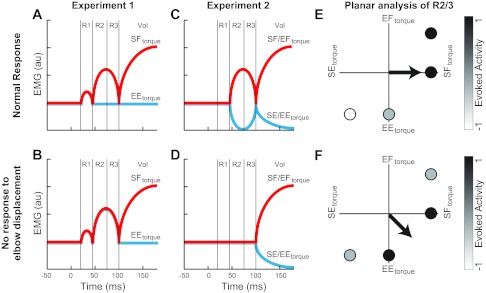Fig. 2.

Contrasting predictions of long-latency response (LLR) of the shoulder extensor muscle following cerebellar damage. A: cartoon of the normal response of the shoulder extensor to the perturbations in experiment 1 where shoulder flexor (SF) torque and elbow extensor (EE) torque cause similar amounts of shoulder motion and different amounts of elbow motion. A similar R1 is evoked, whereas later periods show larger activity for the shoulder torque than the elbow torque perturbation. The same pattern is predicted if LLRs are minimally impacted by cerebellar damage. au, Arbitrary units. B: predicted pattern of shoulder extensor LLR if cerebellar damage eliminates the ability to respond to elbow motion: LLR would be identical for the 2 conditions with the normal magnitude when responding to shoulder torque. C: cartoon of the normal muscle response in experiment 2: flexor torque at both joints (SF/EF) and extensor torque at both joints (SE/EE) cause substantial elbow motion and a negligible amount of shoulder motion. Normally, subjects have no evoked R1, whereas the later periods show reciprocal increases and decreases in activity for the flexor torque and extensor torque perturbations. D: predicted pattern of the shoulder extensor's LLR if cerebellar damage eliminates the ability to respond to elbow motion: LLR would not be evoked for the 2 conditions. E: diagram of the predicted “preferred torque direction” (PTD) for control subjects shown in shoulder-elbow torque space. Graph depicts the predicted activity of LLR to the 4 torque conditions of experiments 1 and 2 (SF, EE, SF/EF, and SE/EE); white shading shows maximal inhibitory responses, whereas black shading shows maximal excitatory responses. The arrow indicates the plane-fit to the activity and is directed toward shoulder flexor torque at 0°. F: predicted PTD for cerebellar-damaged subjects. The arrow indicates the plane-fit and is directed toward midway between shoulder flexor torque and elbow extensor torque at 315°.
